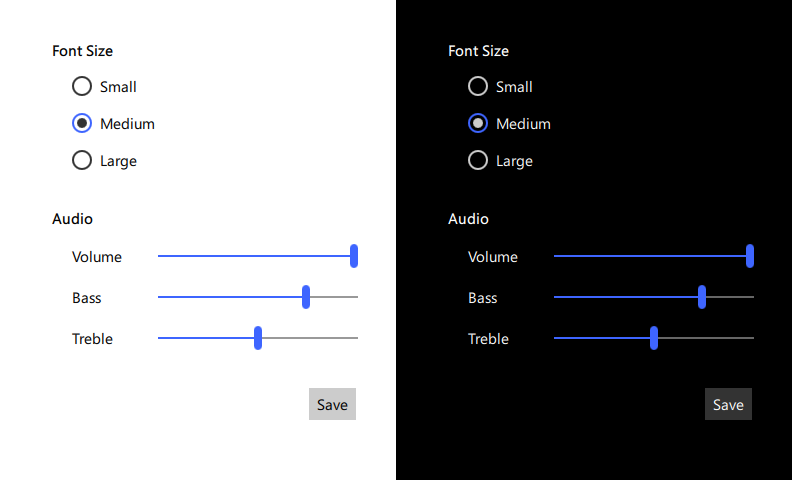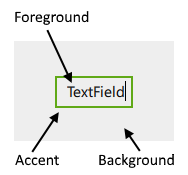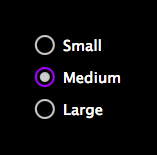Universal Style
The Universal Style is based on the Microsoft Universal Design Guidelines. More...
| Import Statement: | import QtQuick.Controls.Universal 2.0 |
| Since: | Qt 5.7 |
Attached Properties
- accent : color
- background : color
- foreground : color
- theme : enumeration
Attached Methods
- color color(enumeration predefined)
Detailed Description
The Universal style is a device-agnostic style based on the Microsoft Universal Design Guidelines. The Universal style has been designed to look good on all devices, from phones and tablets to PCs.

The Universal style in light and dark themes
To run an application with the Universal style, see Using Styles in Qt Quick Controls 2.
Note: The Universal style is not a native Windows 10 style. The Universal style is a 100% cross-platform Qt Quick Controls 2 style implementation that follows the Microsoft Universal Design Guidelines. The style runs on any platform, and looks more or less identical everywhere. Minor differences may occur due to differences in available system fonts and font rendering engines.
Customization
The Universal style allows customizing four attributes, theme, accent, foreground, and background.

The following example illustrates how to create a red stop button with light text:
import QtQuick 2.0 import QtQuick.Controls 2.0 import QtQuick.Controls.Universal 2.0 Button { text: "Stop" highlighted: true Universal.accent: Universal.Red Universal.theme: Universal.Dark } |
|
Both attributes can be specified for any window or item, and they automatically propagate to children in the same manner as fonts. In the following example, the window and all three radio buttons appear in the dark theme using a violet accent color:
import QtQuick 2.0 import QtQuick.Controls 2.0 import QtQuick.Controls.Universal 2.0 ApplicationWindow { visible: true Universal.theme: Universal.Dark Universal.accent: Universal.Violet Column { anchors.centerIn: parent RadioButton { text: qsTr("Small") } RadioButton { text: qsTr("Medium"); checked: true } RadioButton { text: qsTr("Large") } } } |
|
In addition to specifying the attributes in QML, it is also possible to specify them via environment variables or in a configuration file. Attributes specified in QML take precedence over all other methods.
Environment Variables
| Variable | Description |
|---|---|
QT_QUICK_CONTROLS_UNIVERSAL_THEME | The value can be one of the available themes, for example "Dark". |
QT_QUICK_CONTROLS_UNIVERSAL_ACCENT | The value can be any color, but it is recommended to use one of the pre-defined Universal colors, for example "Violet". |
QT_QUICK_CONTROLS_UNIVERSAL_FOREGROUND | The value can be any color, or one of the pre-defined Universal colors. |
QT_QUICK_CONTROLS_UNIVERSAL_BACKGROUND | The value can be any color, or one of the pre-defined Universal colors. |
Dependency
The Universal style must be separately imported to gain access to the attributes that are specific to the Universal style. It should be noted that regardless of the references to the Universal style, the same application code runs with any other style. Universal-specific attributes only have an effect when the application is run with the Universal style.
If the Universal style is imported in a QML file that is always loaded, the Universal style must be deployed with the application in order to be able to run the application regardless of which style the application is run with. By using file selectors, style-specific tweaks can be applied without creating a hard dependency to a style.
Pre-defined Universal Colors
Available pre-defined colors:
| Constant | Description |
|---|---|
Universal.Lime | #A4C400 |
Universal.Green | #60A917 |
Universal.Emerald | #008A00 |
Universal.Teal | #00ABA9 |
Universal.Cyan | #1BA1E2 |
Universal.Cobalt | #3E65FF (default accent) |
Universal.Indigo | #6A00FF |
Universal.Violet | #AA00FF |
Universal.Pink | #F472D0 |
Universal.Magenta | #D80073 |
Universal.Crimson | #A20025 |
Universal.Red | #E51400 |
Universal.Orange | #FA6800 |
Universal.Amber | #F0A30A |
Universal.Yellow | #E3C800 |
Universal.Brown | #825A2C |
Universal.Olive | #6D8764 |
Universal.Steel | #647687 |
Universal.Mauve | #76608A |
Universal.Taupe | #87794E |
See also Default Style, Material Style
Attached Property Documentation
Universal.accent : color |
This attached property holds the accent color of the theme. The property can be attached to any window or item. The value is propagated to children.
Note: Even though the accent can be any color, it is recommended to use one of the pre-defined Universal colors that have been designed to work well with the rest of the Universal style palette.
Universal.background : color |
This attached property holds the background color of the theme. The property can be attached to any window or item. The value is propagated to children.
The default value is theme-specific (light or dark).
Universal.foreground : color |
This attached property holds the foreground color of the theme. The property can be attached to any window or item. The value is propagated to children.
The default value is theme-specific (light or dark).
Universal.theme : enumeration |
This attached property holds whether the theme is light or dark. The property can be attached to any window or item. The value is propagated to children.
Available themes:
| Constant | Description |
|---|---|
Universal.Light | Light theme (default) |
Universal.Dark | Dark theme |
Attached Method Documentation
color color(enumeration predefined) |
This attached method returns the effective color value of the specified pre-defined Universal color.
import QtQuick 2.0 import QtQuick.Controls.Universal 2.0 Rectangle { color: Universal.color(Universal.Red) }

